Main menu
Common skin conditions

NEWS
Join DermNet PRO
Read more
Quick links
Parsnip — extra information
Common name: |
Parsnip |
|
Botanical name: |
Pastinaca sativa |
|
Family: |
Apiaceae – Carrot family |
|
Origin: |
Parsnips originated in the Mediterranean, where wild forms were used for food by the early Romans. By the 16th century, parsnips were cultivated in western Europe, particularly the Rhine Valley. |
|
Description: |
Wild parsnip is a member of the Umbelliferae (parsnip) family. They have a tough, creamy white root, tapering somewhat from the crown, from which arises the erect stem, 30-60 cm high. The leaf-stalks are about 20 cm long, the leaves divided into several pairs of leaflets, each 2-5 cm long, and upto 2cm wide. All the leaflets are finely toothed at their margins and softly hairy, especially on the underside. The flowers are yellow and in umbels at the ends of the stems, similar to the carrot. The flowers of the cultivated Parsnip are a deeper yellow colour than those of the wild plant. |
|

Uses: |
The food value of Parsnips exceeds that of any other vegetable except potatoes. Wild parsnip is now considered a biennial weed in Europe and America. In Holland, Parsnips are used in soups, whilst in Ireland cottagers make a beer by boiling the roots with water and hops, and afterwards fermenting the liquor. A kind of marmalade preserve has also been made from them, and even wine which in quality has been said to approach the famed Malmsey of Madeira. The fruit is flattened and of elliptical form, strongly furrowed. Parsnip ‘seeds’ as the fruit is commonly called, are pleasantly aromatic, and were formerly collected for their medicinal value and sold by herbalists. They contain an essential oil that has the reputation of curing intermittent fever. A strong decoction of the root is a good diuretic and assists in removing obstructions of the viscera. It has been employed as a remedy for jaundice and gravel. |
|
Allergens: |
Furocoumarins. Possible role of infection with Sclerotinia sclerotiorum. |
|
Allergy: |
Wild parsnip can cause phytophotodermatitis. If the plant juices come in contact with skin, in the presence of sunlight, a rash and/or blistering can occur, as well as skin discoloration that may last several months. Phototoxic, [urticaria]/topics/urticaria-an-overview) and allergic contact dermatitis have also been reported. In one study, itching and tingling with or without oedema of the lips, mouth and tongue were the most common complaints after eating raw parsnip. In addition, laryngeal and abdominal disturbances, rhinitis and hand dermatitis have been recorded. |
|
Cross reactions: |
Other umbilliferae |
|
Other information: |
Part of the parsnip's attraction as a vegetable is its ability to be frozen in the ground, thawed out in the soil, and then later eaten. Since parsnip roots tend to shrivel easily in storage, they are quite often heavily waxed when marketed in retail channels. According to Pliny, Parsnips were held in such repute by the Emperor Tiberius that he had them annually brought to Rome from the banks of the Rhine, where they were then successfully cultivated. They are dressed in various ways and are much eaten with saltfish during Lent. |
|
Patch test: |
Photo patch test |
|
References
- Aberer W. Occupational dermatitis from organically grown parsnip (Pastinaca sativa L.). Contact Dermatitis. 1992 Jan;26(1):62.
- Bang Pedersen N, Pla Arles UB. Phototoxic reaction to parsnip and UV-A sunbed. Contact Dermatitis. 1998 Aug;39(2):97.
- Botanical Dermatology Database. http://www.botanical-dermatology-database.info/
- Egan CL, Sterling G. Phytophotodermatitis: a visit to Margaritaville. Cutis. 1993 Jan;51(1):41-2.
- Federico GP. [Study and report of a case of phytodermatosis caused by Pastinaca sativa]. Arcisp S Anna Ferrara. 1957;10(1):111-9. [Article in Italian]
- Hannuksela M, Lahti A. Immediate reactions to fruits and vegetables. Contact Dermatitis. 1977 Apr;3(2):79-84.
- Kubeczka KH, Stahl E. [On the essential oils from the apiaceae (umbelliferae) II. The essential oils from the above ground parts of Pastinaca sativa (author's transl)]. Planta Med. 1977 Feb;31(2):173-84. [Article in German]
- Lovell CR.1993, Plants and the Skin, Blackwell, Oxford.
- Lutchman L, Inyang V, Hodgkinson D. Phytophotodermatitis associated with parsnip picking. J Accid Emerg Med. 1999 Nov;16(6):453-4.
- Mitchell JC, Rook A, 1979, Botanical Dermatology, Plants and Plant products injurious to the skin, Greengrass, Vancouver.
- Picardo M, Cristaudo A, de Luca C, Santucci B. Contact dermatitis to Pastinaca sativa. Contact Dermatitis. 1986 Aug;15(2):98-9.
- Poljacki M, Paravina M, Jovanovic M, Subotic M, Duran V. [Contact allergic dermatitis caused by plants]. Med Pregl. 1993;46(9-10):371-5. [Article in Croatian]
- Sommer RG, Jillson OF. Phytophotodermatitis (solar dermatitis from plants). Gas plant and the wild parsnip. N Engl J Med. 1967 Jun 29;276(26):1484-6.
- Uecker S, Jira T, Beyrich T. [The production of furocumarin in Apium graveolens L. and Pastinaca sativa L. after infection with Sclerotinia slcerotiorum]. Pharmazie. 1991 Aug;46(8):599-601. [Article in German]
